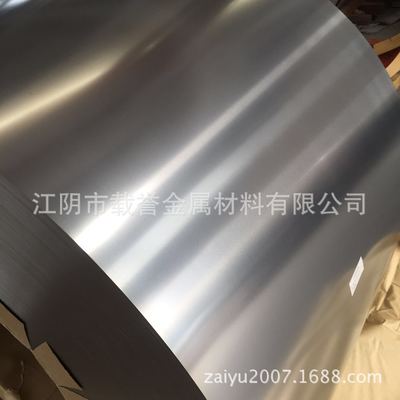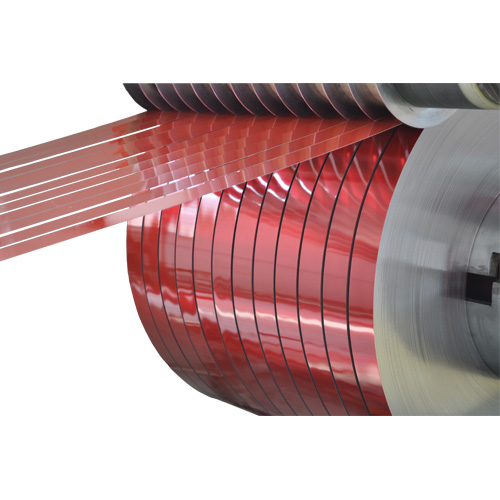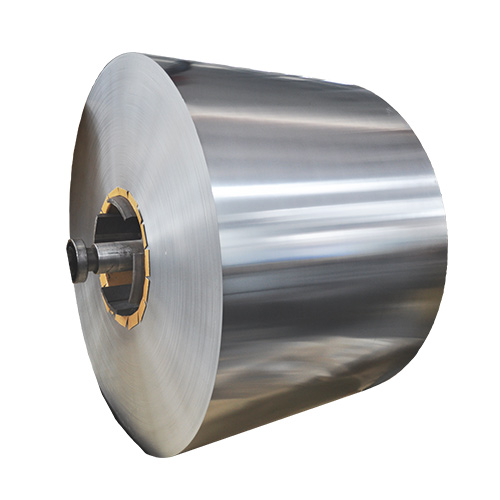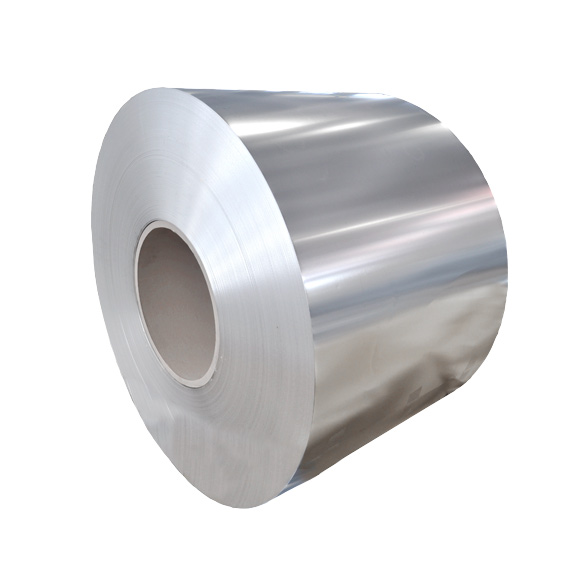Tin Free

Chrome-Plated Sheet Steel (T F S)
Chapter 1 Preface
The so-called Tin Free Steel(TFS) refers to "no tin but can replace tinplate use of coated steel plate". Again, TFS originally referred to any type of steel plate suitable for such use, but later specifically to thin steel plate treated with chromate electrolysis. The bottom layer of the sheet is chromium metal, and the top layer is covered with a thin film made of chromium's hydration oxide.
In order to gradually replace tinplate, the development of nickel plating, aluminum plating and other thinner plating of thin steel plate, chromium acid impregnation treatment of thin steel plate, phosphate liquid treatment of thin steel plate chemical treatment and so on. But these products from its quality characteristics, production costs, are more than by chromic acid electrolytic treatment, the bottom is chromium metal, the surface is composed of chromium hydration compounds of the thin steel plate is poor, so only the latter type of thin steel plate can replace tinplate. In order to distinguish this Type of TFS from other types of TFS in the United States, it is called TFS-CT (Tin Free Steel-Chromium Type) or TFS-CCO (Tin Free Steel-CrCr2O3 Type). But these days, whenever we talk about TFS, we mean the TFS of chromate electrolytically treated thin steel plates. Therefore, all TFS-CT or TFS-CCO presented in this paper are referred to as TFS.
TFS is considered a newly developed canning material with a relatively short history, so public information on its production methods is still scarce. It IS A PITY THAT WE CANNOT GO INTO DETAIL HERE, BUT WE WILL DO OUR BEST TO COLLECT MORE research AND survey data to meet the needs of our readers.
Chapter 2: History of TFS
As for the food can material, as mentioned in the History of tinplate, it has been valued and favored by people since the beginning of the 19th century, and with the change of dietary life, its demand has increased significantly. Even at present, it still maintains its dominant position as the mainstream can material. But it is well known that tinplate is a tin plating product on thin steel plate, and because tin production is limited to Southeast Asia, Bolivia and other countries, in the Second World War, the United States has felt the shortage of tin supply. Coupled with the political instability of these tin-producing countries themselves, tin supply will be interrupted at any time, and tin resources are increasingly exhausted.
As the demand for tin increased significantly during the Second World War, the technology for making electroplated tinplate was rapidly developed, and the traditional hot-dip tinplate with high tin content was changed to electroplated tinplate with low tin content. But this kind of tinplate with less tin plating has poor corrosion resistance.
For this reason, a manufacturing method of surface chemical treatment after electroplating was developed to enhance its corrosion resistance, as shown in Table 2-1, the anodic and cathodic treatment methods were used in aqueous solution mainly with chromate and dichromate. This thinking later led to the development of electrolytic phosphate treatment of thin steel plates.
Table 2- 1 Surface treatment of tinplate
Temperature of handling liquid
When ℃ between
(sec) current density
A/dm2 Cited literature
Drug concentration PH
Na2CrO4 · 4 h2o
Na3PO4 12 1% h2o
0.25% 11.3 21 Anodic treatment 0.6
Cathode treatment 2.4 9.3 Stevens-on-&
Schaub
K2CrO4 0.5-5% cathodic treatment of 1-10 1-2(4.5V) Prust
Na2Cr2O7 · 2 h2o
Containing phosphate 0.2-3% 2-7 26.7 Cathodic treatment followed by anodic treatment of Neish
In addition to adopting such tinplate manufacturing methods to reduce the amount of tin, we are looking forward to the emergence of a can material that does not use tin at all.
As A new can material to replace tinplate, it must be considered whether it can satisfy the following characteristics.
(1) Pay attention to no small linear rust in storage and transportation.
(2) The use of coatings and printing ink and other organic processing agents, thin steel plate surface has good infiltration, and coating, printing can not occur fisheye defects.
(3) Coating and printing after baking, punching, extrusion processing and other forming, can not cause coating peeling.
(4) Coating and printing after baking, for a variety of canning content corrosion resistance to be better.
(5) It has a high-speed canning operation comparable to the tinplate can body soldering operation.
The above are not the use of tin new can material should have the characteristics, and this new can material manufacturing method, should be as simple as possible, the design and construction of the production line should be easy; In addition, it is more economical and faster than the manufacturing engineering of tin plating can material, which are the conditions that new can material should have.
And can meet the above mentioned conditions, the first is developed by the United States of the two chemical treatment of thin steel plate method is the most eye-catching. Faced with a shortage of tin during the Korean War, American industry developed the sheet steel. Which high-profile Heintz is one of the chemical processing of steel Manufacturing and development of chromic acid hot dipping treatment ハ イ ナ ッ ク. A rival to this is the phosphate electrolytic treatment steel plate developed by U.S.Schumel.
Heintz Manufacturing, which had successfully developed the HEINAC manufacturing process, established a Pilot line with Bethlehem Steel in 1953 at the company's Sparrows Point plant to supply large quantities of test sheet steel to canning companies.
Various TESTS OF THE sheet steel PRODUCED by the above METHOD PROVED TO BE A better tank MATERIAL for liquid synthetic DETERGENT than tinplate, AND THE rapid increase in the production of liquid synthetic detergent led to the commencement of continuous production in August 1954. Furthermore, American Can is implementing the HEINAC manufacturing process at its new facility in Hamilton. Around 1955m, in order to compete with HEINAC's manufacturing method, U.S.S. teel Company developed a phosphate electrolytic treatment steel plate based on phosphoric acid and sodium dichromate aqueous solution by using thin steel plate as cathode for electrolytic treatment. This steel plate was intended to be used as canning material for liquid synthetic detergent, but its corrosion resistance and other aspects are worse than those of the HEINAC manufacturing method, so its development in this field cannot be as fast as that of the HEINAC manufacturing method.
Throughout the development of phosphate electrolytically treated steel plates, even to improve the shortcomings of the U.S.S. teel manufacturing method, the use of changes in the type of subsidy additives, and a slight increase in PH, etc., were tested. However, the results do not improve the utility of its use. We arranged this phosphate electrolytic treatment as shown in Table 2-2.
Table 2-2 Electrolytic phosphate treatment method
The polarity and time (S) temperature of the treatment solution treated by the metal
℃ current density
A/dm2 Cited literature
Drug concentration PH value
Na2Cr2O7 · 2 h2o
PO4-3
nitrate
Or potassium permanganate 1 ~ 6%
1 ~ 8.4%
1 ~ 4%
0.1 ~ 0.4% 1 ~ 2 iron
The cathode
The anode
0.25 ~ 2 49 ~
60 1.6 ~ 9.7 NEISH
CrO3
PO4-3
Zn.Mg.Ca.Mn phosphate 5 ~ 50g/L
50 ~ 100g/L iron and zinc cathode
< 0.25 10 ~
80 1.1 ~ 3.2 Ikeda Yizaki
CrO4-2, Cr2O7-2
PO4-3
PO4-3/CrO4-2
Or Cr2O7-2
Non-ionic interface active agent 0.03 ~ 0.3
0.1 ~ 0.5 g/L
2:1 ~ 4:1
0.05 ~ 0.5% 2.0 ~ 5 iron cathode
2 ~ 3 50 4 Matsuda fresh ze
CrO4-2,Cr2O7-2
PO4-3
Nitrate, permanganate, etc., non-ionic interface active agent 0.03 ~ 0.3
0.1 ~ 0.3 g/L
0.1 ~ 3% and 1.0 ~ 5 iron are interactively processed by adding AC at the cathode
5 ~ 30 40 ~
70 DC 3 ~ 7
Ac 0.1-100C /S
0.5 ~ 8
Matsuda bright ze
In addition, since 1956, Bethlehem Steel and Republic Steel in the United States had developed a manufacturing method that could compete with HEINAC manufacturing method and phosphate electrolytic treatment method. Their surface treatment was cathodic reduction method of chromic acid aqueous solution. Thus a surface treatment method was developed to form a layer of cathode skin film on the thin steel plate. This is the origin of chromate electrolytic treatment of thin steel plate. However, the initial chromic acid electrolytic treatment, the resulting skin film is just a kind of inhomogeneous chromium hydration oxide, yellow film and brown film in the majority. This film will be rough powder granular, so can not be used.
In addition, Japan has been devoted to the research of electrolytic treatment of chromate since 1955, and published various methods as shown in Table 2-3 and Table 2-4 from 1959 to 1973. First, the Hi-Top industrial production of Toyo steel plate in 1961 opened the prelude to the mass production of today's TFS. Hi-Top manufacturing method has the tendency to replace tinplate, first was widely used in art cans, mixed cans and other household goods can industry. In 1962, Fujifilm Steel began producing Cansuper, a chrome-plated steel plate. At that time, Hachata iron production was based on the generation of chromium hydrate oxide on the steel plate to improve its corrosion resistance. At that time, a large number of papers on chromate electrolytic treatment were published and practical tests were carried out. However, in these methods, especially in the case of transparent raka, the product has interference color, so the color is dark. The corrosion resistance becomes worse after heating. Therefore, in addition to further research and improvement of this method, a primary electrolytic treatment method, such as Hi-top manufacturing method, has been developed. This new method is to form a skin film composed of chromium metal and chromium hydration oxide on the steel plate. In 1966 we called the products produced by this method Supercoat and started production. After that, Hachiman and Tomato Iron merged into New Japan Iron, and with the birth of this new Japan Iron, from July 1971, the two iron mills began to produce TFS, collectively known as Cansuper. Then in 1972, Japanese steel pipe began the real production of TFS, and named Britecote officially launched. The current Hi-Top, Cansuper and Britecote have their own characteristics in their manufacturing methods, and the surface coating formed, no matter which is the TFS formed by the extremely thin metal chromium layer and the hydration oxide layer of chromium.
Table 2-3 Chromic acid electrolytic treatment of hydrated oxides forming chromium
The polarity and time (S) temperature of the treatment solution treated by the treated metal
(° C) current density
A/dm2 references
The literature
Drug product concentration degrees
CrO3
H3BO3, Na2O7
10H2O
Cr+3(full chrome) 100 ~ 400g/L
8 g/L ~ saturated
2 ~ 18% Fe and Zn cathode
> 10 20 to 45 5.4 to 32 Wick
CrO3
H3BO3, Na2O7
10 h2o 100 ~ 400 g/L
8g/L ~ saturated Fe, Zn,
Sn, cathode > 21 5.4 ~ 32 Wick
Schneide-wind
CrO3
H3PO4
CrO3 / H3PO4 10 ~ 35%
3 ~ 12%
2 ~ 3% Fe, Cu,
Ni, Sn, anode
The cathode
1 to 20 36 to 66 8.1 to 54 Loveland
Prust
CrO4-2 Cr2O7-2
Cr+3 (reduced with tartaric acid, nitric acid, etc.) 0.1 ~ 15%
0.1 ~ 10% Fe cathode
> 0.25 20 ~ 80 1.1 ~ 3.2 Toshima
M battery
kamata
CrO3
Cr+3
H3PO4
H3BO3 10 ~ 20 g/L
1 ~ 5 g/L
3 ~ 10 g/L
1 ~ 20g/L Fe cathode
> 0.25 15 ~ 18 1.1 ~ 3.2 meters
kamata
Na2Cr2O7 H3PO4
(NH4)2SO4
CO(NH2)2
Any of Cr2(SO4)3 200g/L Fe, Zn,
Sn cathode 10 ~ 60* 30 ~ 50* 40* Sekawa
sakai
Cr+6
Cl- or F-5 ~ 50g/L
10 ~ 200 mg/L
PH<1.3 Fe cathode 1 ~ 3(example) 10 ~ 80 11.6 ~ 32
(Example) Yousaki
kamata
sakai
pool
Cr+6
Halooxic acid ion 1 ~ 200g/L
Fe, Zn, PH<1.5
Al cathode 0.1 ~ 1 10 ~ 90 6 ~ 20
(Example) Yousaki
kamata
Temple mountain
And nearly
CrO3
K3AlF6 10 ~ 300 g/L
0.5 ~ 2 g/L
Fe cathode
5
(Example) 20 ~ 60 5 ~ 100 Okada
tamura
CrO3 100 ~ 150g/L Fe cathode 1 ~ 5 45 ~ 60 22~86 GURRY
CrO3
Acid containing Ti, W, Mo, Se, Zn, V, As 10 ~ 100g/L
0.1 ~ 5 g/L
Tellurium acid
10 ~ 100g/L Fe cathode
<5 20 ~ 60 10 ~ 50 Wells
Mr Okada
CrO3 (Example)
Fluorosilicate 50g/L
2 g/L Fe cathode
2 40 5 Uchida
LiuFu
Table 2-4 Chromic acid electrolytic treatment of hydrated oxides formed from chromium metal and chromium
The polar temperature of the treated liquid treated by the treated metal
℃ current density
(A/dm2) time
(sec) References
The drug concentration
CrO3
Aromatic disulfide acid 20 ~ 100g/l
0.2-4.0g/l Fe, Al cathode 40 ~
70 1 ~ 30 North Village
CrO3
Cr+3
H2SO4
A compound of fluorine
Cr + 6 / Cr + 3 40 ~ 100 g/l
0.2 2.5 g/l
0.1 0.3 g/l
< 1.0 g/l
20 ~ 150 Fe, Al cathode 40 ~
70 12.5< appropriate pericytes
kitamura
dry
CrO3
Cr2 (SO4) 3 or
- H2SO4 10 to 50 g/l
0.2 ~ 5%
(the needle
Pre:no more
Next:no more






 Scan to add WeChat
Scan to add WeChat